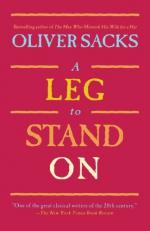|
This section contains 653 words (approx. 2 pages at 400 words per page) |

|
A Leg to Stand On Summary & Study Guide Description
A Leg to Stand On Summary & Study Guide includes comprehensive information and analysis to help you understand the book. This study guide contains the following sections:
This detailed literature summary also contains Topics for Discussion and a Free Quiz on A Leg to Stand On by Oliver Sacks.
This memoir relates the experience of noted neurologist and author Oliver Sacks, who, after years of having a position of authority over his patients, experiences a severe injury and discovers what it feels like to become a patient himself. From this new perspective, he examines the healing process and comes to what he feels are some important conclusions about the nature of the physician/patient relationship in general, and of his own injury in particular.
The narrative begins with the author's colorful description of the beginning of his happy, peaceable, trip up a challenging mountain in Norway. He writes of the various plants and vistas he observes, of his confusion at seeing a sign warning him of a bull where, he thinks, no bull is likely to be, and of his confidence that he will both complete his climb and be back at the nearby village well before sundown.
A surprise encounter with the bull, however (which is simultaneously much larger than the author imagined and, apparently, entirely peaceful), triggers in the author a surge of raw fear that sends him racing down the mountain. A sudden and unremembered fall leaves him with a severe injury to his leg which he splints with his never-forgotten umbrella so that he can make his way down the isolated, un-peopled hill to safety. He doesn't get as far as he would like, however, leaving him within sight of the village but not within shouting range, despairing of rescue. Fortunately, he is discovered by a pair of reindeer hunters, one of whom goes for help while the other keeps the author company.
Help soon returns, and the author is taken to the small local hospital, where he encounters the brusque Nurse Solveig and the inspiring Dancing Intern. Initial repair work on his leg results in its being put in a cast and the author being prepared for transport to a hospital in London, where he is to be further treated. In both hospitals, the author is surprised to learn, he is not treated with the respect he feels should be accorded to someone of his status and reputation within the medical community. He feels instead like he has been told most patients feel - like a bother or a nuisance to the medical professionals involved in his treatment. In the meanwhile, as he is feeling useless and ignored, he discovers that his leg is not functioning properly and self-diagnoses nerve damage. The doctors, however, insist there's nothing wrong with him and seem to be paying no attention to his concerns.
As he becomes more and more frustrated with both the lack of healing in his leg and with the lack of evident concern and support from the medical profession, the author makes important discoveries about both his experience of suffering, such as how isolating it is, and of the healing process, including how it takes its own time and its own form. At one point he discovers a connection between the power of composed music and what he calls an "inner" music. A deepening awareness of this last sort of music, he writes, plays a key role in the sudden return of feeling and function to his leg. Eventually, with the help of physiotherapists and other physicians, the author becomes able to leave the hospital and move into a convalescent home. There he is able to continue the healing process, and at the same time begin the process of transitioning from the relative peace and quiet of the hospital into the much busier, more active and more demanding day to day world.
The book's final chapter details the author's investigations into the history of the strange sense of dislocation and loss he felt in relation to his leg, his discoveries of several recorded instances of other patients experiencing similar dislocations, and his development of several theories about why and how such dislocations occur.
Read more from the Study Guide
|
This section contains 653 words (approx. 2 pages at 400 words per page) |

|



